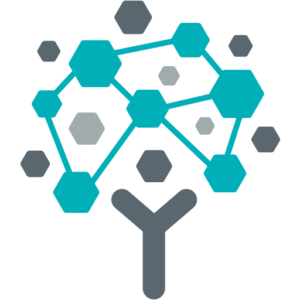Accounting for a high school can be complex, especially if your district has multiple campuses. Managing income or expenses can quickly become unwieldy, and manual processes can make this process time-consuming and error-prone. Fortunately, you can automate your fund accounting with a configurable, comprehensive system for financial management like MIP Fund Accounting®.
Automating your fund accounting can offer numerous benefits to your school district. To determine whether this is the right option for your educational institution, we cover what fund accounting is, the differences between traditional accounting and automated accounting, the benefits of accounting software, and the benefits of upgrading to the cloud. Start the new year off right: automate your fund accounting and serve your high school student body.
What Is Fund Accounting?
Fund accounting is a type of accounting used by nonprofit organizations to track the funds assigned to different purposes and the usage of these funds. Since nonprofits like school districts do not operate to generate a profit, fund accounting focuses on accountability. Educational institutions use fund accounting to gain enough information to make informed financial decisions about how to use limited resources and how to report the usage of these funds to third parties.
If your school district uses several funds, each may require a separate balance sheet. By separating funds, you can determine whether your funds are being used for their intended purposes. Fund accounting also limits how specific funds can be used and helps your institution better maintain control over your expenditures.
Traditional Accounting vs. Automated Accounting for School Districts
Accounting involves maintaining your school district’s financial accounts, entering data, and preparing for audits. Due to advances in technology, many school districts now use automated accounting software, though some organizations still rely on manual accounting processes.
What Is Traditional Accounting?
Also referred to as manual accounting, traditional accounting is an accounting process that relies on paper-based or manual processes. If your organization uses traditional accounting, you may use journals or notebooks to record your financial transactions. Manual accounting can be time-consuming and prone to human error. However, for organizations that have few transactions, traditional accounting may be the most cost-effective option. Since this accounting method doesn’t require the internet, your organization’s data is also protected from online theft or cyberattacks.
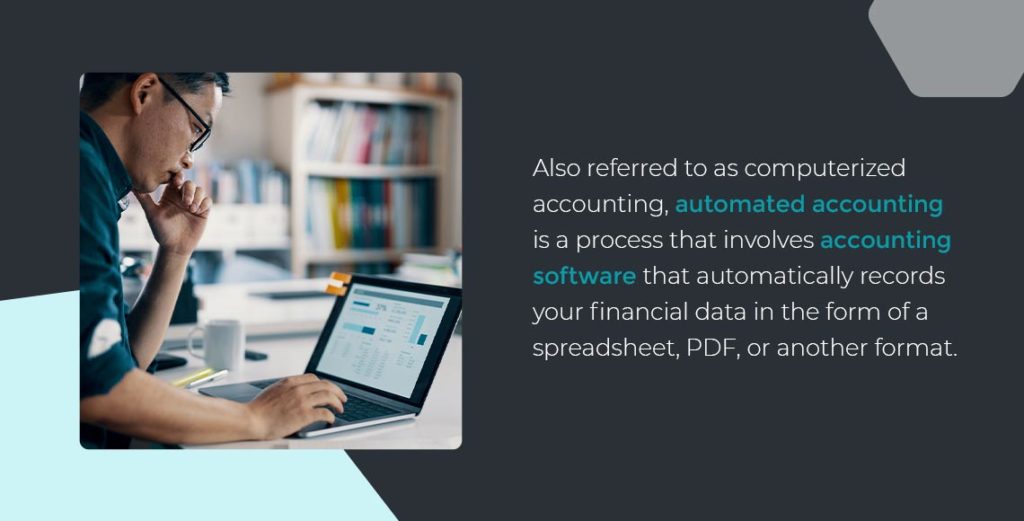
What Is Automated Accounting?
Also referred to as computerized accounting, automated accounting is a process that involves accounting software that automatically records your financial data in the form of a spreadsheet, PDF, or another format. Unlike traditional accounting, this type of accounting is quick and systematically automated. You need a computer and the appropriate software to use this method of accounting.
Automated accounting is also less prone to human error, and the process is streamlined with automated entries and calculations. You can easily maintain and access all your organization’s transactional information and use this data to analyze your operations.
Differences Between Traditional and Automated Accounting
Automated accounting involves software-based operations, while traditional accounting is the process of manually recording financial accounts with physical ledgers or books. The additional differences between traditional and automated accounting include:
- Entry time: Automated accounting is much faster, making your operations more efficient. On the other hand, traditional accounting is a more time-consuming process, as it involves manually recording each transaction. Since school districts can deal with numerous financial transactions, automated accounting can save your staff a great deal of time.
- Users: Traditional accounting is more often used by small organizations, while automated accounting is commonly used by larger organizations that deal with more transactions and financial data.
- Access speed: One of the most noticeable differences between traditional and automated accounting is how quickly you can complete processes. With automated accounting, you can plug your data into formulas that instantly perform calculations for you. Access your data whenever you need it, and use it to analyze your operations and complete reports.
- Storage: Traditional accounting requires physical storage space to contain your records and ledgers, while automated accounting requires less physical space for storing documents. The only physical space you need for automated accounting is enough to accommodate the computers used.
- Editable: With traditional accounting, it can be much more tedious and difficult to edit your manual entries. Automated accounting, on the other hand, makes editing your entries and formulas easy.
- Security: Traditional accounting methods may be safe from cyberattacks, but they can still be stolen or compromised from their physical storage area. Automated accounting may be at risk for cyberattacks, but anti-hacking software can be installed to add protection. Your data will also be protected from physical theft.
- Backups: If your school district relies on manual accounting, you could risk losing valuable data. Important papers could be damaged or lost, meaning your staff must recreate them. Though you can make copies of your essential documents, this process can be time-consuming and expensive. With automated accounting, you can back up your data online, on a flash drive, or on an external hard drive. If something happens to your system, you can restore your data from your backups.
- Accuracy: Accounting software has dramatically increased the accuracy of calculations. Calculations in traditional accounting are more prone to error and can be especially time-consuming. However, automated accounting lets you easily add up numbers in different columns, copy and paste numbers to other pages, and compile financial statements. Automated accounting allows you to skip manual calculations and simply put formulas into your software or spreadsheet.
- Reporting: Reporting can be tedious with traditional accounting, as you have to pull your information from several different ledgers for a report. A computerized accounting system makes reporting much faster by automatically compiling the report for you.
- Searching: When you use automated accounting, you can keep all of your data organized and in a single place. Finding and accessing your educational institution’s data is much easier than it is with traditional accounting. While traditional accounting requires you to comb through rows of data manually, with automated accounting, you can use system functions to find the information you’re looking for quickly.
- Margin of error: Since transactions are recorded precisely via automated accounting, the chance of error is much lower. Traditional accounting is much more prone to human error because of its reliance on manual processes.
- Tax compliance: Dealing with tax compliance is far easier with automated accounting than with traditional accounting. If you are concerned about tax compliance and want to make the process as streamlined and simple as possible, you may want to implement automated accounting software in your district.
- Additional device: With traditional accounting, you need additional devices to accomplish your process, such as calculators for simple arithmetic. Automated accounting software can perform all the necessary functions and calculations, so you don’t need any additional devices to complete the accounting process.
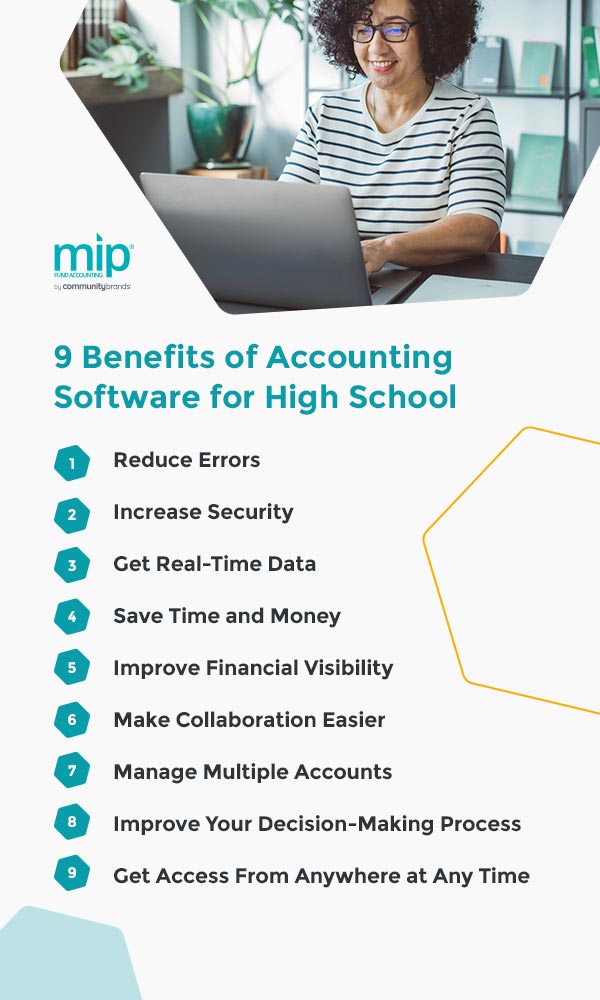
9 Benefits of Accounting Software for High School
Many organizations can benefit from implementing accounting software, especially high schools. The following are the main advantages of using accounting software for your high school:
1. Reduce Errors
One of the greatest advantages of accounting software for high schools is that it reduces errors. When you have to rely on an accountant’s precision, the risk of errors is higher and can negatively impact the accuracy of your data. By relying instead on an automated system, you can trust computerized formulas and calculations. Software can also detect errors, such as duplicate entries, that staff could easily overlook.
2. Increase Security
Accounting software protects your data using encryption algorithms, which can make it safer to store your sensitive data on your cloud platform than on an office shelf. You can also protect your data from being wiped, corrupted, or destroyed. As an admin, you can grant access rights to certain users, allowing them to view financial statements or perform different accounting processes, so those who don’t need to access certain information won’t be able to view it.
3. Get Real-Time Data
Unlike traditional accounting, automated accounting software for a high school enables your district to track financial data in real-time. Whenever you need to know the amount of money going in and out of your organization, you can access your software to find real-time data. This function allows you to develop the right strategies and determine how to improve your educational institution’s financial management.
4. Save Time and Money
Automating your accounting process can save both time and money. Your school likely has many transactions to record. With automated accounting, you can complete the process quickly and return your focus to other tasks that serve your student body. When switching to automated accounting software, you can import your data in bulk effortlessly. Since you can easily import data from other software, you can save time that you would otherwise need to spend entering each piece of data manually.
Additionally, automated accounting software can save your school district money that you would otherwise spend on extra accountants or bookkeepers to handle the process manually. You can also save money by reducing the amount of paperwork you deal with and store.
5. Improve Financial Visibility
An automated accounting system makes it easy for staff, administrators, and stakeholders to monitor your institution’s financial position. You can keep track of total funds and expenses, along with transactions across different departments and campuses. Use a financial dashboard to get a comprehensive view of all your financial information quickly.
6. Make Collaboration Easier
Accounting software makes it easier for school staff to collaborate on the process. Say goodbye to the days of making changes to a spreadsheet, sending it to colleagues, and consolidating the data. Instead, any user with granted access can make edits in real-time. This allows your staff to avoid wasting time sending the same information back and forth or correcting accidental mistakes.
Depending on your organization’s needs and requirements, your staff can also collaborate on generating the multiple reports you need, such as:
- Expense
- Trial balance
- Daily income
- Bank reconciliation
- Overall balance sheet
- Cash and bank transaction
7. Manage Multiple Accounts
Your school district may have multiple campuses and accounts to manage. The right automated accounting software allows you to manage several accounts in a single place. Whatever your organization’s specific requirements, you can create multiple accounts, such as a school account, trust account, and expense account. You can also manage student fees with the help of automated fund accounting software.
8. Improve Your Decision-Making Process
Automated accounting software allows you to generate real-time reports that are accurate and complete. With these reports, you can make better decisions for your school district’s operations and finances. Identify which processes are the most costly to determine how you can reduce costs. You can also use the information in your software to determine whether you can expand and hire new employees.
9. Get Access From Anywhere at Any Time
With automated accounting software, you can access your information anytime as long as you have an internet connection. This also means you can perform your accounting tasks from anywhere. You can also access accounting software from any mobile device, such as a tablet or smartphone, so you can conveniently monitor your income and expenses regardless of your location.
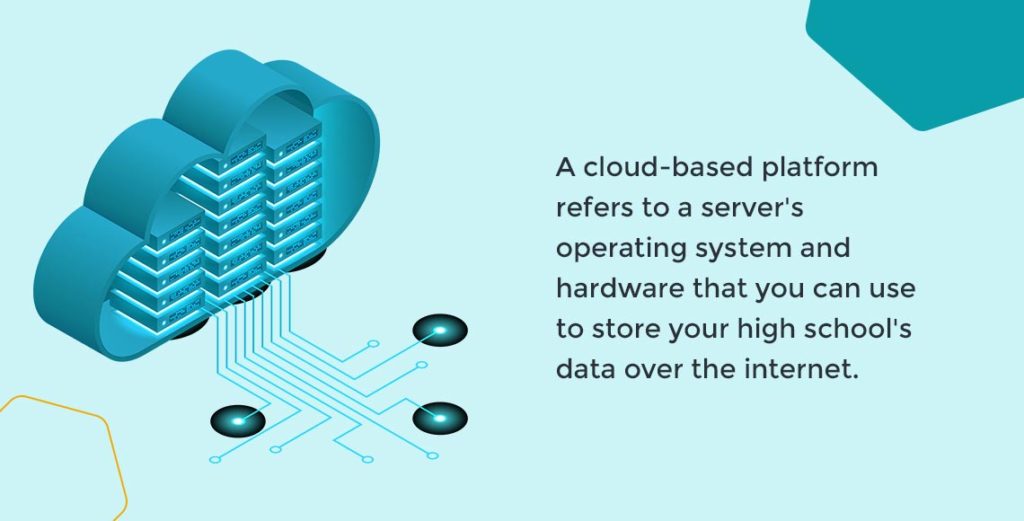
Benefits of Upgrading to the Cloud
A cloud-based platform refers to a server’s operating system and hardware that you can use to store your high school’s data over the internet. Cloud-based platforms allow your hardware and software to exist together remotely. The benefits of upgrading to the cloud for your high school include:
- Scalability: With the cloud, you can quickly scale up or down as your operations and storage needs change.
- Lower costs: When you upgrade to the cloud, you pay for only the services you use, which can dramatically reduce the costs associated with accounting, like hardware and utilities. You may even be able to reduce your IT team and avoid downtime costs.
- Remote data access: Upgrading to the cloud allows you to maintain accurate and transparent accounting records that you can access from anywhere, including mobile devices.
- Reminders and notifications: By upgrading to the cloud, you can send automatic reminders and notifications to students and parents regarding fees, collections and bill payments. You can send these notifications via messaging or email.
- Customization and integration: Cloud accounting is customizable, so you can adjust it to your school’s exact needs. You can also seamlessly integrate your accounting with third-party applications.
- Lack of software or hardware installation: One of the most cost-effective aspects of upgrading to the cloud is that you don’t need to install hardware or software. Alternatively, because the cloud is cost-effective, you can free up resources to invest in better hardware and software.
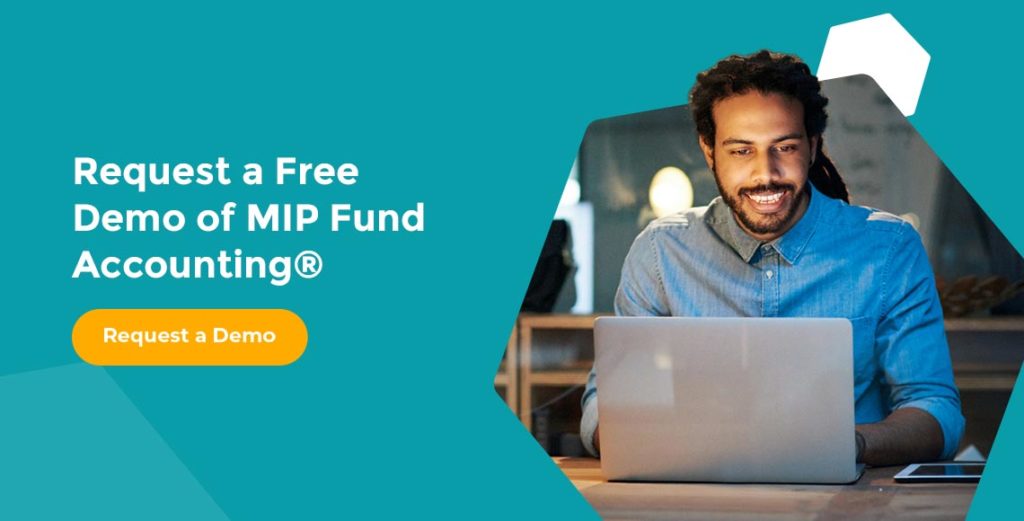
Request a Free Demo of MIP Fund Accounting®
At MIP®, we are one of the nation’s leading providers of cloud-based fund accounting. For more than four decades, our trusted solution has been used by K-12 schools, nonprofits, associations, and government entities to reach their goals and achieve their missions. We help districts like yours improve financial decision-making and operate more efficiently. Additionally, we can help you gain total financial oversight.
Your educational institution can benefit from our technology and experienced team. Request a free demo of MIP Fund Accounting® to automate your fund accounting and effectively serve your high school student body.
Share this post
